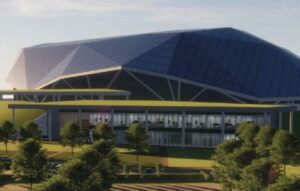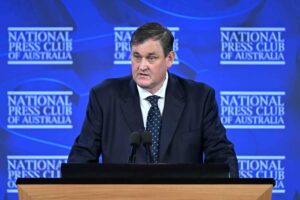The bias of the South Australian Nuclear Fuel Cycle Royal Commission ‒ and the state government’s push to turn the state into the world’s nuclear waste dump ‒ is finally being exposed. RenewEconomy ran an article about some of these problems in April but other media publications have been slower to catch on.
Yesterday, ABC radio’s AM program ran a story about the conflict of interest underpinning the economic case for importing nuclear waste and journalist Stephen Long followed up with an online article.
The ABC revealed ‒ if revealed if the word, since others have raised these issues previously ‒ that the consultancy firm hired by the Royal Commission, Jacobs MCM, has deep links to the nuclear industry. Specifically, the economic report was written by Charles McCombie and Neil Chapman, the president and vice president of ARIUS, the Association for Regional and International Underground Storage.
ARIUS is a lobby group promoting nuclear waste dumps (which it calls “multinational facilities”) and nuclear power. As the ABC noted, ARIUS’s motto is: “The world needs nuclear power ‒ nuclear power needs multinational facilities”.
ARIUS is the successor to the infamous Pangea Resources, an international consortium that secretly developed plans to build an international high level nuclear waste dump in Australia. Pangea’s existence wasn’t known until a corporate video was leaked to Friends of the Earth in 1998. Pangea set up an office in Australia but gave up in 2002 ‒ $600 million poorer ‒ in the face of overwhelming public and political opposition.
Charles McCombie, co-author of the Jacobs MCM report, was heavily involved in Pangea Resources. Likewise, former Pangea chief Jim Voss is heavily involved in the current push for South Australia to accept foreign nuclear waste, as an ‘Honorary Reader’ at UCL Australia and a member of UCL Australia’s Nuclear Working Group. In the late 1990s, Voss denied meeting with federal government ministers when he had in fact met at least one minister ‒ Wilson Tuckey. A Pangea spokesperson said: “We would not like to be lying … we very much regret getting off on the wrong foot.”
Needless to say, the conflicted economic report produced by Jacobs MCM predicted that South Australia would become filthy rich if the state agrees to import 138,000 tonnes of high level nuclear waste and 390,000 cubic metres of intermediate level nuclear waste.
Commissioning Jacobs MCM might have been reasonable if it was just one of a number of economic reports ‒ but it was the only such report. And its fanciful conclusions were uncritically accepted and promoted by the Royal Commission ‒ and more recently by the SA government.
The Royal Commissioner, retired Rear Admiral Kevin Scarce, denied claims of a conflict of interest. He told the ABC: “The conflict of interest would arise if they [Jacobs MCM] were the only source of information that we were using to assess the evaluation. They were not.”
Scarce’s claim is false. As Prof. Barbara Pocock, an economist at the University of South Australia, told the ABC: “All the economists who have replied to the analysis in that report have been critical of the fact that it is a ‘one quote’ situation. We haven’t got a critical analysis, we haven’t got a peer review of the analysis”.
Another South Australian economist, Prof. Richard Blandy from Adelaide University, said last week: “The forecast profitability of the proposed nuclear dump rests on highly optimistic assumptions. Such a dump could easily lose money instead of being a bonanza.” Blandy contributed a submission to the Royal Commission but was not invited to speak at the Commission’s public hearings.
SA Conservation Council CEO Craig Wilkins said that asking pro-nuclear advocates to provide “independent” advice was “like asking the crew of the Sea Shepherd to provide an independent review of whaling in the Antarctic.”
The Jacobs MCM report estimated that the total costs associated with the project would amount to a whopping $145 billion. And while some allowance is made for cost overruns, both Jacobs MCM and the Royal Commission glossed over massive cost overruns evident overseas. Estimates of the clean-up costs for a range of (civil and military) UK nuclear sites have nearly doubled over the past decade. Estimates of the cost of a building a deep underground nuclear waste dump in France have nearly doubled over the past decade.
And between 2001 and 2008, the estimated cost of constructing the Yucca Mountain nuclear waste dump in the US and operating it for 150 years increased by 67 percent. The Yucca Mountain project was abandoned by the Obama administration, so the US wasted A$17.8 billion on a failed repository project.
The Jacobs MCM report is honest enough to state that many of its assumptions are highly speculative; for example, no-one knows which countries might want to off-load their nuclear waste to South Australia or how much they might be willing to pay. But the speculative nature of its findings was downplayed in the Royal Commission’s report and has been largely ignored by the SA government and its Nuclear Consultation and Response Agency.
The Australia Institute crunched the numbers presented in the Royal Commission’s interim report and wrote a detailed rebuttal. Kevin Scarce responded on ABC radio on 31 March 2016, saying that the Royal Commission would “take apart” the Australia Institute’s report “piece by piece”. When asked if such an aggressive attitude was appropriate, Scarce said: “I’m a military officer, what would you expect?”
Also attracting media attention yesterday was DemocracyCo, the company running the SA government’s Citizens’ Jury process ‒ 350 randomly-selected South Australians have been asked to explore the merits of the nuclear waste import plan and to make recommendations to government. The Citizen Jurors were asked to nominate ‘witnesses’ they wished to speak to, but DemocracyCo manipulated the witness list by adding three people ‒ all of them pro-nuclear ‒ without the Jurors’ knowledge or consent.
Back to the beginning
Before his appointment as the Royal Commissioner, Kevin Scarce said little about nuclear issues but what he did say should have excluded him from consideration. Speaking in November 2014 at a Flinders University guest lecture, Scarce acknowledged being an “an advocate for a nuclear industry”. Just four months later, after his appointment as the Royal Commissioner, he said the exact opposite: “I have not been an advocate and never have been an advocate of the nuclear industry.”
Other than generalisations, and his acknowledgement that he is a nuclear advocate, Scarce’s only comment of substance on nuclear issues in his 2014 lecture was to claim that work is “well underway” on a compact fusion reactor “small enough to fit in a truck”, that it “may be less than a decade away” and could produce power “without the risk of Fukushima-style meltdowns.” Had he done just a little research, Scarce would have learnt that Lockheed Martin’s claims about its proposed compact fusion reactor were met with universal scepticism and ridicule by scientists and even by nuclear industry bodies.
So the SA government appointed Scarce as Royal Commissioner despite knowing that he is a nuclear advocate who has uncritically promoted discredited claims by the nuclear industry. Scarce appointed an Expert Advisory Committee. Despite claimingthat he was conducting a “balanced” Royal Commission, he appointed three nuclear advocates to the Committee and just one critic. There wasn’t even a single, token critic on the staff of the Royal Commission.
More recently, the SA government’s Nuclear Consultation and Response Agency is conducting a thinly-veiled state-wide promotional exercise under the guise of ‘consultation’ and the Agency doesn’t have even a single, token nuclear critic to provide any balance to its nuclear advocates.
Given the make-up of the Royal Commission, it came as no surprise that numerous questionable claims by the nuclear industry were repeated in the Royal Commission’s report released in May 2016. Critical analyses of the Royal Commission’s findings are posted online. Suffice it here to mention one example here. The Commission’s main recommendation was to import 138,000 tonnes of high level nuclear waste for disposal in a deep geological repository. Yet the Commission’s report only offered a few sentences on the world’s one and only deep geological repository ‒ the Waste Isolation Pilot Plan (WIPP) in the US, shut down since 2014 because of a chemical explosion in an underground nuclear waste barrel.
Kevin Scarce said that WIPP received little attention because it involved different waste forms (long-lived intermediate level waste). But the high level nuclear waste that he wants South Australia to import is vastly more hazardous than the waste managed at WIPP, so Scarce’s argument is disingenuous.
While completely ignoring the world’s one and only existing deep underground nuclear waste dump, the Royal Commission’s report went into detail about deep underground repositories under construction in Finland and Sweden. According to the Royal Commission’s report, those two countries “have successfully developed long-term domestic solutions” for nuclear waste. But in fact, neither country has completed construction of a repository let alone demonstrated safe operation over any length of time.
The Royal Commission also had little to say about failed repository projects. Incredibly, the Royal Commission ‒ and now the SA government ‒ want to import many thousands of tonnes of nuclear waste before construction of a repository even begins, and 50,000 tonnes of high level waste before a repository begins accepting waste. What if it proves impossible to build a repository for one reason or another ‒ as has the been the case in many countries around the world? There is no Plan B.
SA Premier Jay Weatherill should initiate a Royal Commission to investigate the discredited, $9 million Nuclear Fuel Cycle Royal Commission. He should also have the decency to fall on his sword for his role in the fiasco.
Weatherill’s exit is looming as a real possibility. He hoped that the state Labor conference on October 29 would give him licence to push ahead with his nuclear waste plans. But he had to defuse a plethora of no-dump resolutions by promising to hold a ‘Special ALP Convention’ to discuss the issue. The resolution read: “This Special ALP Convention should be held at the conclusion of community consultation and before a decision is made on the development of a high level nuclear waste repository in SA.”
Yet days later, on November 1, Weatherill denied that he had made a commitment to hold a special convention. He told Parliament: “There is no upcoming special convention. There will be a special convention at a time when it is necessary. It is not going to happen anytime soon. It may be a question of years away”.
There is plenty of angst within the state Labor Party (an election is just over a year away) and there will be plenty more as a result of Weatherill’s welshing on his promise to hold a special convention.
And there is plenty of public opposition: a protest rally in Adelaide on October 15 attracted 3,000 people; Aboriginal Traditional Owners are overwhelmingly opposed to the nuclear waste plan and are fighting hard to stop it; trade unions and churches are speaking out in opposition; and the SA Liberal Party is hedging its bets by pointing to the huge upfront costs (estimated at between $600 million and $2.4 billion) that the state would need to gamble before any income was generated.
Last but not least, the Citizens’ Jury finalises its report this weekend. Despite the manipulation of the Citizens’ Jury process, there is no guarantee that it will deliver Jay Weatherill the recommendations he seeks.











